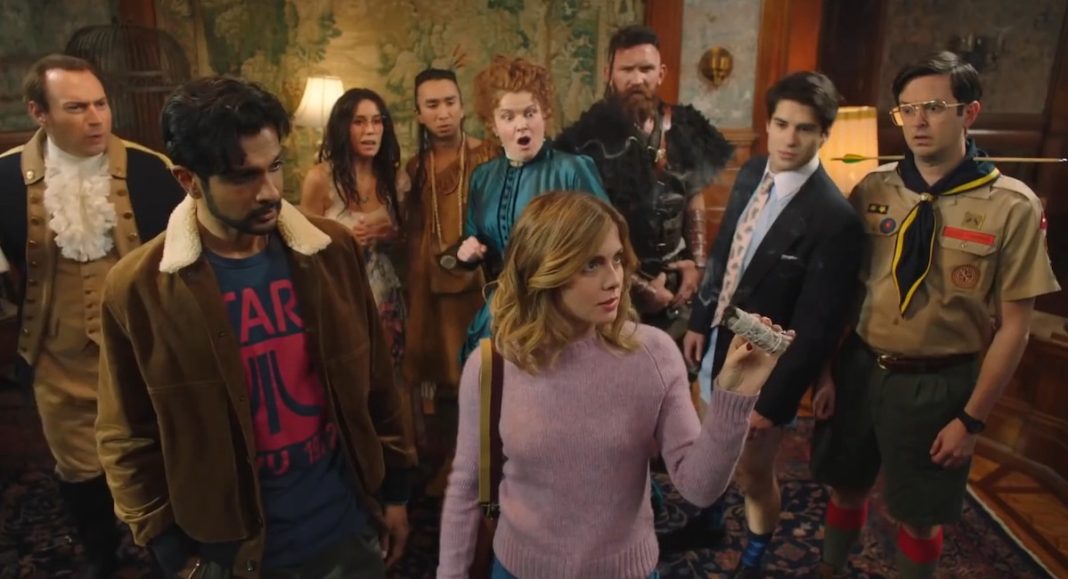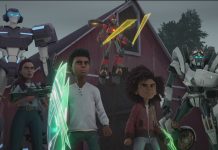By Daniel Rasmus
Paranormal consultant Aaron Sagers stood on the Ballroom 20 stage alone. It looked like he was about to interview some actual ghosts as the seats on the dais next to him, which are usually full of vibrant panelists, sat empty. What would normally be a raucous, behind-the-scenes actor, producer, showrunner, and director celebration of the show they collaboratively create, had instead, in Star Trek speak, “de-evolved” into a screening of an episode of the show everyone had seen, a trivia contest, and an extended behind-the-scenes segment.
Sagers showed the Ghosts Season 2 finale, which, in a way, made us all Samantha during the running time as we projected Isaac, Albert, Pete, Trevor, Flower, Hetty, Thor, Sasappis, and Nigel into the empty dais seats. Who would sit where? What would they say? Able only to project the characters into those seats. For many, this event would have been their first experience of the actors in a real space.
Some might still find themselves bemused by Rose McIver’s charming New Zealand accent. Asher Grodman’s analysis of his role would paint him as more than a pantless player. Sheila Carasco’s insightful answers in full, articulate sentences would bely her character’s drug-addled eternity. And while we did not learn anything new about the actors who portray the owners and ghostly residents of Woodstone Estate, we did learn a few things about Ghosts fans, most pointedly, that they are not Star Trek fans.
The trivia contest, which was the only audience engagement offer, could have, as Sagers quipped, “gone better.” He was referring to the general lack of specific knowledge about the show, the kind of details that Star Trek fans famously hoard in a treasure trove of trivia recall, often more immediately and with more intimacy than those associated with this show.
Sagers and the CBS staff ended up spoon-feeding answers to the grateful fans as they vied for swag. No one cared that they didn’t know the answers. Most of the audience didn’t know the answers. A few people randomly shouted out guesses, some correctly, to help their fellow Ghosts fan along.
In a regular San Diego Comic-Con year, trivia would have been a warm-up or an add-on. The real draw was a stage full of actors providing attendees with a personal touch, a detail exclusive to that room, at least for the moment.
That this was a Ballroom 20 event, a rather full one, spoke to fandom’s stalwart dedication to the shows they love. The Ghosts panel was the perfect reflection of a panel in a period where writers and actors picketed up the 5 Freeway in Los Angeles. It was a fan event, and at least on this one day in July 2023. It was okay to support those on strike and to be satisfied with simply being fans. Once resolved, the actors, showrunners, and writers will return.
The Ghosts panel reflected an odd Comic-Con, at least an odd modern Comic-Con, where fans have come to expect spectacle and new disclosures, along with unique, exclusive moments. This year, however, San Diego Comic-Con returned to its roots, becoming a purely fan event, with energy coming not from the preternatural world of Hollywood, but from the bumps of bags and backpacks along the show floor, from elbows touching in the too-tightly packed program rooms, and from the joy of recognizing shared love for ideas that strive not just to entertain, but to engage the imagination, and in a way, help viewers and readers create their own worlds.
The empty Ghosts stage forced the audience to create their own story about what might have been. And while telling stories may only be part of Comic-Con’s mission, fueling imagination is what draws attendees to San Diego each July. That they had to work a little harder this year to create their own moments is probably a good thing for them and a good thing for Comic-Con’s resilience.









